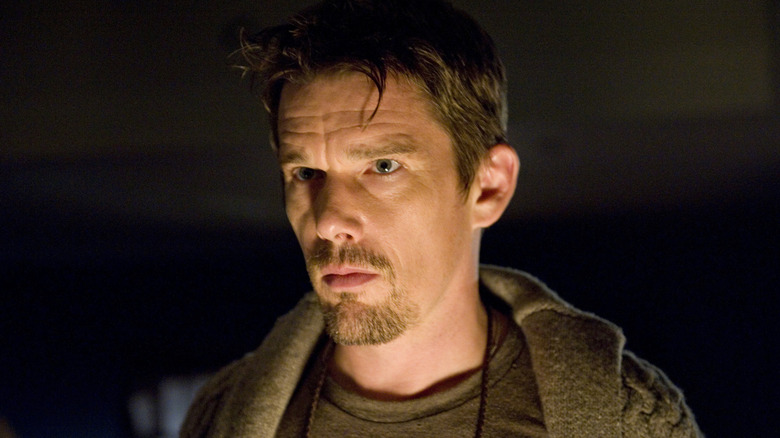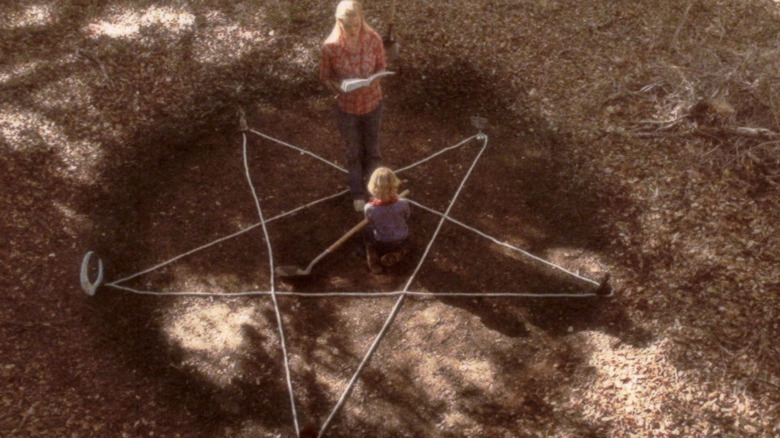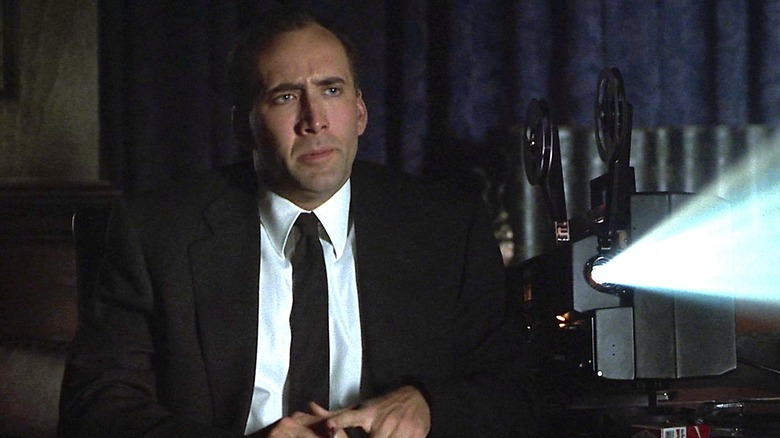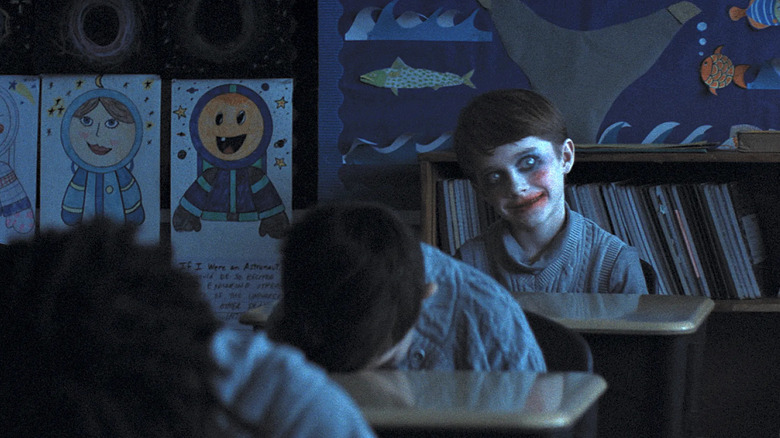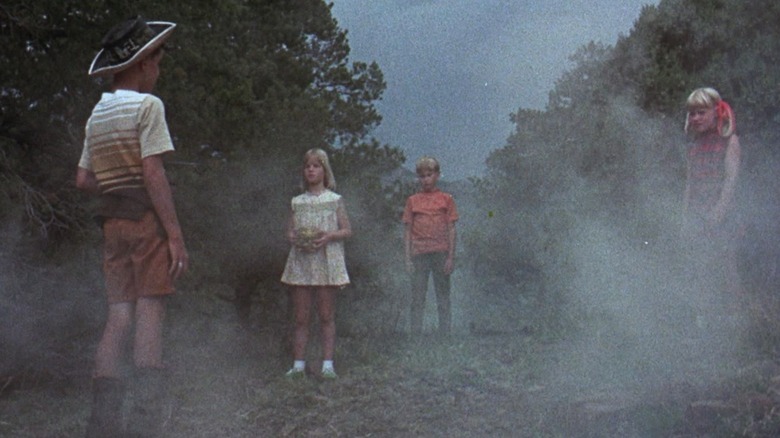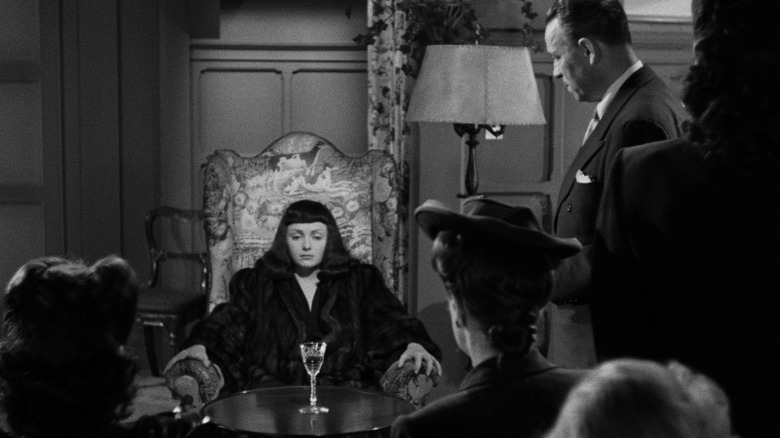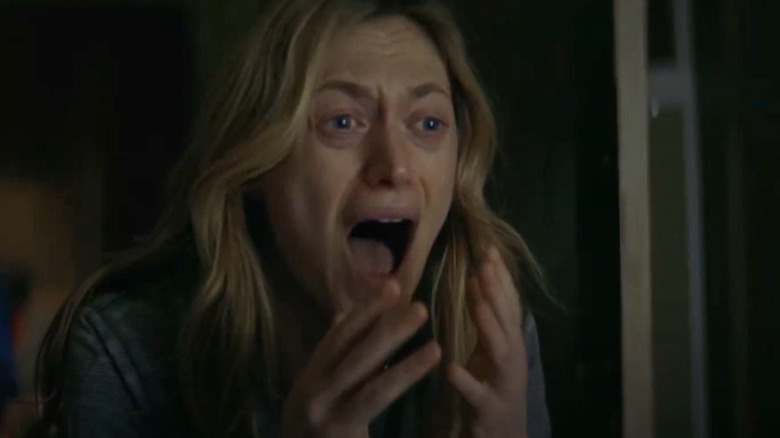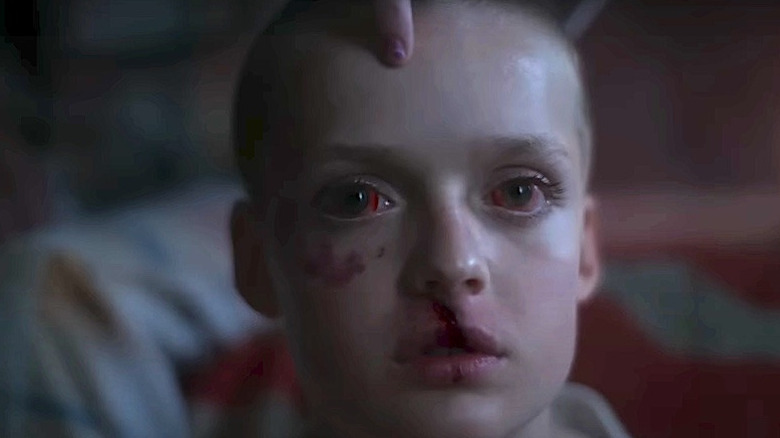12 Terrifying Horror Movies Like Sinister
Just how terrifying is "Sinister"? Scott Derrickson's 2012 supernatural thriller been scientifically proven to be one of the scariest movies ever made — a label already awarded to the film by Reddit — by the U.K.-based Broadband Choices. Their Science of Scare project monitored the heart rate of test subjects while watching horror films, and found in 2020 that "Sinister" elevated viewers' beats per minute (BPM) 22 points over their resting heart rates. "SInister" has since been undone by "Host" (which we ranked as one of the best horror movies of 2020), but that doesn't take away the fact that "Sinister" is a pulse-pounding experience.
What frightened audiences about "Sinister" was its relatively simple story. Struggling author Ellison Oswalt (Ethan Hawke) moves his family into a house where the previous owners were killed to research a book. He discovers a box of Super 8mm movies that depict other killings, as well as a supernatural figure. The connection between the two elements is teased out through disturbing phenomena, which Oswalt finally deciphers — Bughuul, a demon who devours the souls of children, is orchestrating the killings — only to find that his own family has been marked for death.
If you're craving more of the ominous atmosphere of "Sinister," you'll get a similar case of the creeps from the following 12 horror films, all of which share aspects of its terrifying DNA.
Antrum: The Deadliest Film Ever Made
Watching the 8mm films in "Sinister" unleashes a supernatural force that leads to the death of protagonist Ellison Oswalt. The gimmick behind the faux lost '70s horror film "Antrum" is that it also exposes the viewer to dangerous evil spirits and certain death, but further extends the curse to anyone watching "Antrum: The Deadliest Film Ever Made" (2018), a mockumentary about the film's history that also includes "Antrum" itself — thereby condemning the home viewer as well.
The mockumentary part of "Antrum" is capably made, detailing the deaths that follow screenings of the film through believable talking head interviews. The fake movie itself is also a fairly accurate carbon of cheap, weird, period horror, filled with woozy plotting (two children set out to rescue their late dog from hell with a magic book that summons demons) and a hypnotic, dream-like tone that echoes the hallucinatory moments in "Sinister."
Directors David Amito and Michael Laicini lace "Antrum" with hidden symbols and subliminal images — all the better to sell the idea that the viewer has sealed their own fate. "It is unlikely to send you to your death, but there's a genuine creepiness, and it will haunt you," wrote Eye for Film. Should you be in the market for a haunting, "Antrum" is one of the many hidden horror gems you can watch right now on Amazon Prime.
8MM
There are no literal ghosts connected to the titular roll of film in "8MM," but it's haunted nonetheless by senseless and depraved death. Haunted is perhaps the most accurate description for Joel Schumacher's grim 1999 thriller, which stars Nicolas Cage as a private investigator hired to determine the authenticity and origin of an alleged snuff film — a movie that shows an actual murder and is produced solely for profit.
Like the "home movies" in "Sinister," the snuff film in "8MM" is a cursed object that devastates everyone that comes in contact with it: Cage's detective and his family, the monstrous thugs (James Gandolfini and Peter Stormare) who created it, and the video store clerk (Joaquin Phoenix) who helps Cage track them down.
Scriptwriter Andrew Kevin Walker, who penned "Seven," disowned "8MM" after Schumacher reportedly lightened the tone without his consent. But if the finished product can't entirely commit to the darkness of the subject matter, much of the film, like "Sinister," is steeped in ugliness and doom, especially for a studio production. "The last two words of the screenplay are 'save me,' and by the time they're said, we know what they mean," wrote Roger Ebert in his review.
Weapons
Just as in "Sinister," a group of children are under the control of a malevolent supernatural force in Zach Cregger's "Weapons." The intent of the entities in both films — Bughuul in "Sinister," and the flamboyant Aunt Gladys (Amy Madigan) in 2025's "Weapons" — is also similar: the demon in "Sinister," known as an "eater of children," possesses young ones to lure them away from their families and consume their souls, while witch Gladys keeps herself alive by enchanting children in order to feed on their life essences.
Both films feature heart-stopping suspense and grisly murders; many adults suffer horrible deaths in both films, though in "Weapons," the children aren't the sole perpetrators. However, their fates in "Weapons" differ from those in "Sinister." Only Clare Foley's Ashley survives at the end of Scott Derrickson's film (after killing her parents and brother), though she's clearly destined as a meal for Bughuul. The missing schoolkids in "Weapons" break free of Gladys's spell and get bloody revenge, though their state at the end of the film is anything but happy.
In our own review of "Weapons," our critic wrote, "'Weapons' begins in a profoundly off-putting place, with the mysterious disappearance of a large group of innocent children. As it goes from there, it's fully willing to take the narrative in weird and disturbing directions."
Who Can Kill a Child?
Though there are plenty of horror movies featuring a single monstrous child, there are also a smaller but significant number of genre titles about groups of killer children who wreak havoc on adults. The premise has been done, to varying degrees of success, in films like "Children of the Corn," "Cooties," and, of course, "Sinister," which reveals that the murders seen in the 8mm films are carried out by children under the sway of Bughuul. One of the less familiar but most effective children-on-the-rampage movies is 1976's "Who Can Kill a Child?"
The Spanish thriller, directed by Narcisco Ibañez Serrador, follows a pair of British tourists who discover that their Mediterranean vacation destination is devoid of residents, save for its children. Gradually, it's revealed that the children have not only murdered all of the island's adults, but also have set their sights on the couple, who are forced to confront the titular question over and over again.
Unrelentingly grim and suspenseful, the film — which alludes to global suffering as the motivation for the children's murder spree — also suggests that moral compunction over committing an unthinkable act falls away in a world awash in senseless violence. As Slant noted, "The closing 10 minutes come from a different era in filmmaking, when horror movies could spit in the eye of the status quo and say that good does not always prevail, no matter how much we'd like it to."
Longlegs
Measure Bughuul against Dale Ferdinand Kobble — aka "Longlegs" — in a Bad Guy face-off, and the only immediate similarity is their choice of nu-metal haircuts. Look beyond that, and you'll start to see a few shared character elements: Both Longlegs and Bughuul use children to achieve their goals, and gain entry into their lives through innocuous means (dolls for Longlegs, home movies for Bughuul).
Both possess the children in order to facilitate the destruction of their families, though the kids in "Sinister" carry out the slaughter, while the Cameras and other families in 2024's "Longlegs" dispatch each other. However, their ultimate goals are different: Bughuul wants to steal the children in order to consume their souls; Longlegs' killing spree appears to be carried out simply in service to "the man downstairs."
Beyond that, the two films share the idea of evil as an inevitability. Both Ellison Oswalt and Maika Monroe's Lee Harker dig deep into their respective mysteries and ultimately discover the grisly secrets behind them — and it accomplishes absolutely nothing. The Oswalts die by their daughter's hand, Harker's mother (Alicia Witt), boss (Blair Underwood), and his wife (Carmel Amit) all die, and Bughuul gets away, while Longlegs gets the final word in the movie, even after killing himself. "It's that sense of evil, with no hope of escape or redemption in sight, that gives 'Longlegs' its unsettling power," wrote NPR.
The Brotherhood of Satan
Though horror movies featuring creepy children proliferated in the 1990s and 2000s, they were also a semi-staple of the genre for more than a half-century. Antecedents include the homicidal Rhoda Penmark in 1956's "The Bad Seed," a gaggle of British schoolchildren possessed by aliens in "Village of the Damned" (1960), and two siblings seemingly in the sway of ghosts in "The Innocents" (1961). From there, the list goes on to include titles from Hollywood, international territories, and the independent scene.
A lesser-known American entry in the "scary children" subgenre is 1971's "The Brotherhood of Satan," a low-budget thriller about a vacationing family trapped in a small town besieged by a witches' coven. The children here are victims, not antagonists, stolen away from their murdered parents to serve as vessels for the souls of the elderly coven members. The unnervingly silent, smiling kids echo those of "The Innocents," while the quietly unfolding suspense predicts the mounting dread of "Sinister"; like the Oswalts in that film, the family and townsfolk know something is wrong, but are powerless to stop it.
"The film displays bold, direct, relatively uncomplicated acceptance of its supernature that seems the essence of fantasy moviemaking and that extends to some wonderfully spooky scenes — in a car, in a family living room — in which nothing quite happens and which are the most terrifying moments," wrote The New York Times.
The Seventh Victim
Val Lewton, who produced some of the most haunting and psychologically complex horror films of the 1940s and '50s — including the original "Cat People" and "I Walked With A Zombie" — oversaw this unusual 1943 thriller with Kim Hunter as Mary, a young woman who discovers that her sister, Jacqueline (Jean Brooks), has been marked for death after leaving a Satanic cult. Though the premise sounds like pure horror, Lewton and director Mark Robson aren't focused on Brooks' attempts to escape her fate; rather, Mary and those around Jacqueline are fighting against the fact that she has accepted that she will die by her own hand (the cult never murders their victims, but instead compels them to take their own lives), making fate the ultimate villain of the piece.
How does this align with "Sinister"? Again, it's the inevitability of evil: Ellison Oswalt believes that he can figure out the mystery behind the film reels, and Mary believes that she can save her sister. And in both cases, they actually succeed — but it does them no good. Evil is simply too powerful a force for one person to overcome. "While very little in the way of horrific action takes place in 'The Seventh Victim,' the film has a haunting, lyrical, overwhelming sense of melancholy and despair to it —death is looked upon as a sweet release from the oppression of a cold, meaningless existence," stated TV Guide.
The Dark and the Wicked
Trickery is at the heart of both "Sinister" and 2020's "The Dark and the Wicked," a critically praised supernatural thriller directed by Bryan Bertino of "The Strangers" fame. Bughuul manipulates Ellison Oswalt into lowering his defenses with strange visions and symbols, as well as those frightening home movies, before revealing that the children of the murdered families are carrying out the crimes. In "Dark and the Wicked," the entity plaguing a remote farmhouse barrages an estranged brother and sister (Marin Ireland and Michael Abbott, Jr.) with nightmarish visions of their dead parents in order to wear them down and eventually claim their lives.
Bughuul relies on haunted house-style phenomena to break Oswalt: weird noises and signs all distract him from the demon's plan. The force in "The Dark" knows how to hit the siblings where it hurts by showing them monstrous manifestations of their parents, with whom they had troubled relationships. Playing on their guilt and grief eventually wears Ireland and Abbott's characters down, though the entity isn't above forcing others to commit ghastly acts of violence to make its point. As Variety wrote, "[Bertino's] evocation of a familiar, domestic world mysteriously sliding into chaos feels all the more blood-curdling because the protagonists' distress and helplessness are emotionally relatable."
Hereditary
One of the most unsettling aspects of "Sinister" is the idea that the Oswalts are powerless to save themselves. Ellison believes that the 8mm film reels are the key to his career revival, but they prove to be the engine of his destruction: He discovers that the previously butchered families went through the same series of events that he's experienced before their deaths. But by the time it's made clear to him, it's far too late.
Once again, that sense of inescapable doom which runs through "Sinister," "Longlegs," and several other films on this list also fuels 2018's "Hereditary." The family in Ari Aster's terrifying feature debut — which we ranked as one of the most disturbing movies of 2018 — is also besieged by frightening supernatural experiences, unaware that all of the seemingly unrelated events are orchestrated by a deceased relative and secret head of a Satanic coven. They are doomed before the events in the film ever take place.
Both films do masterful jobs at pulling the wool over audiences' eyes, only to pull it away at the last moment to reveal horrible truths. "The audience, of course, tries to fit all these pieces together, but what it can't guess (yet) is that the afterlife, in 'Hereditary,' isn't just a glorified costume-shop spook show designed by a clever filmmaker to terrify the characters (and the audience)," observed Variety. "What we're seeing is the afterlife mounting a total emotional takeover of the here and now."
Bring Her Back
The obvious axis between "Sinister" and Danny and Michael Philippou's "Bring Her Back" is the supernatural intrusion into a family unit. The siblings in the Philippous' 2025 follow-up to "Talk to Me" are more fractured than the Oswalts, having lost their father and found a strange new home with Laura (Sally Hawkins), a grieving mother with a fixation on her deceased daughter. But what further unites the films — and makes them unbearably creepy — is their willingness to portray young adults and children as both victims and monsters in graphic terms.
A shocking number of children die awful deaths in "Sinister," while others are revealed to be the culprits behind those grisly murders. In "Bring Her Back," foster children Billy Barratt and Sora Wong are subjected to astonishing mental and physical abuse by Hawkins, but their suffering pales in comparison to the fate of Jonah Wren Phillips' Oliver, whom Hawkins has abducted to carry out a horrifying ritual that will bring her dead daughter back to life.
The demon-possessed Oliver descends into a zombie-like state that eventually encompasses self-mutilation and cannibalism; it's difficult to consider whether Phillips' performance or the character is more shocking. "It's a horror preying with hideous expertise on our protective instincts towards the vulnerable, our fear of our own vulnerability, the shame and guilt of abuse, and survivors' wretched sense of loyalty to their abusers," wrote The Guardian.
The Babadook
Another family faces an otherworldly threat in 2014's "The Babadook," and though the stakes resemble those in "Sinister," the fight itself, and the outcome, are very different. At the beginning of both films, the families in question are under pressure, though Amelia (Essie Davis of "Alien: Earth") and son Samuel (Noah Wiseman) face a tougher road — Amelia's husband is dead, leaving her emotionally unable to help Samuel's psychological struggles — than the financially strapped Oswalts.
Still, their exhaustion and turmoil is the same fertile ground for the supernatural, which again finds its way in through a seemingly harmless source, a pop-up book about a monster called Mister Babadook. Again, strange phenomena signal its attempts to enter their world (hallucinations plague both Amelia and Ellison), and the being shares a goal of total destruction with Bughuul, though here, the unwilling perpetrator is Amelia.
Where the road divides for "The Babadook" and "Sinister" is Amelia's response; realizing that the monster is using her pain to carry out its scheme, she fights back and ultimately brings it under her control. Using a horror film to address suffering and grief puts "The Babadook" closer to "Hereditary" than "Sinister," but both films share similarly ominous tones and are harrowing to watch. No less an authority than "The Exorcist" director William Friedkin stated in a 2014 post on X (then known as Twitter), "It will scare the hell out of you as it did me."
No One Gets Out Alive
Though not quite as successful a horror exercise as "Sinister" or the other films mentioned on this list, Santiago Menghini's "No One Gets Out Alive" merits mention here for its murky visual palette and baleful ghosts, which both approximate the gloom and grimness in "Sinister." It also features a monster-god of sorts, though one with a bit more mercy in its palette than Bughuul.
Menghini and scripters Jon Croker and Fernanda Coppel (adapting a novel by "The Ritual" author Adam Nevill) are mostly successful at merging haunted house elements with a timely story of immigrants and the challenges they face while trying to adapt to life in America. They're well supported by Cristina Rodlo's sympathetic turn as a new arrival from Mexico, who finds that her temporary home in a boarding house is rife with the same sort of alarming visions as the Oswalts' house, including wandering spirits and strange noises.
The payoff is tense and gruesome, but lacks the nastiness of Scott Derrickson's film. Still, as an atmospheric effort with a unique angle, "No One Gets Out Alive" is worth a look. "The mostly Romania-shot thriller still somehow succeeds primarily in the vividness of its physical environ, an impressively decrepit boardinghouse that seems to swallow up vulnerable young women whole," wrote Variety in its review.
